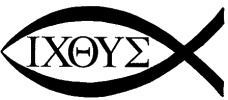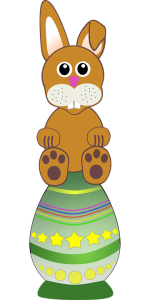The Easter Symbols are representations that are part of the Holy Week rituals.
Easter is an important festival for Christians as it celebrates the death and resurrection of Jesus Christ, a biblical episode interpreted as the passage to new times and new hopes for the humanity. Easter is celebrated on a mobile date, always between the 22nd of March and the 25th of April.
During Holy Week, several symbols are part of the ritual of commemorations, including:
 the palm branches
the palm branches
Holy Week begins with Palm Sunday, which commemorates Jesus' entry into Jerusalem, when people covered the road with palm leaves to celebrate his arrival.
Today, palm leaves are used in the decoration of churches during Holy Week celebrations, as a sign of “welcome to Christ”.
Lamb
 This is one of the oldest symbols of the Passover, recalling the covenant that God would have made with the Jewish people in the Old Testament.
This is one of the oldest symbols of the Passover, recalling the covenant that God would have made with the Jewish people in the Old Testament.
At that time, Passover was celebrated with the sacrifice of a lamb.
For Christians, Jesus Christ is "the lamb of God who took away the sins of the world."
bells

Bells are an important symbol of Easter. Every Easter Sunday, Catholic church bells ring festively to commemorate the resurrection of Jesus Christ. The bells are an announcement of Jesus' victory over death and of hope for all Christians.
Bread and wine

The bread symbolizes the body and the wine symbolizes the blood of Christ. These two elements appear in the Last Supper, when Jesus and his disciples celebrate the Jewish Passover. The Last Supper is remembered on Maundy Thursday, when the most important moment of Holy Week begins: the Easter Triduum.
Taking the bread, he gave thanks, broke it, and gave it to the disciples, saying: “This is my body given for you; do this in memory of me”. Likewise, after supper, he took the cup, saying: “This cup is the new covenant in my blood, poured out for you. (Luke 22:19-20)
Paschal candle
The Pascal Candle is a large candle, decorated with the Greek letters alpha and omega, meaning “beginning” and “end”, respectively, and used during Holy Week masses.
During the Easter Vigil, the five points of Christ's wounds on the cross are inserted into the candle.
It is lit on Hallelujah Saturday and its Light represents the Resurrection of Christ.
The fish
The fish is a symbol brought from the apostles who were fishermen.
 It is a symbol of life used by early Christians in the acrostic IXTUS - fish in Greek.
It is a symbol of life used by early Christians in the acrostic IXTUS - fish in Greek.
The letters are the initials of "Iesus Xristos Theos Huios, Sopter", which means "Jesus Christ, Son of God, the Savior".
It is part of the Holy Week ritual to eat fish on Good Friday, to remember the ritual of 40 days of meat fasting, followed by Christians during Lent.
Find out more about the meaning of fish at easter.
Easter egg
Because it represents birth and life, giving eggs was an ancient custom among the peoples of the Mediterranean.
 During the festivities to celebrate the beginning of spring and the planting season, eggs were boiled, painted and presented to represent fertility and life.
During the festivities to celebrate the beginning of spring and the planting season, eggs were boiled, painted and presented to represent fertility and life.
The custom came to be followed during the festivities of Christians, where they were painted with images of Jesus and Mary, symbolically representing the birth of the Messiah.
Many cultures maintain this custom to this day. In the modern world, the chocolate egg has become a tradition as a gift on Easter Sunday.
Learn more about the meaning of Easter egg.
Easter Bunny
 The Easter rabbit has become the symbol of fertility and life, due to the particularity of this animal to reproduce in large litters.
The Easter rabbit has become the symbol of fertility and life, due to the particularity of this animal to reproduce in large litters.
It is related to Easter in that it represents the hope of life in the Resurrection of Jesus Christ.
Several ancient peoples already considered the rabbit as a symbol of fertility, as with the arrival of spring, they were the first animals to come out of their holes.
With the passage of time, the chocolate bunnies entered the customs of the Easter Week festivities.
Like chocolate eggs, bunnies have become a tradition as a gift on Easter Sunday.
Read more about the meaning of Easter Bunny.
meaning of easter
Easter is a very important festival for Christians, which culminates in the celebration of the resurrection of Jesus Christ on Easter Sunday. The word Passover comes from the Hebrew peach, which means "passage" or "to pass beyond".
The rituals that precede Holy Week begin 40 days before Easter, a period known as Lent - when Christians become dedicate to the penance of fasting, to remember the 40 days spent by Jesus in the desert and also the suffering he endured in the crucifixion.
Holy Week begins with Palm Sunday, which recalls Jesus' entry into Jerusalem, where the road was decorated with palm leaves.
Friday is the day of the celebration of Jesus' death on the Cross. Hallelujah Saturday is the day of the celebration of the midnight mass, on the way to Resurrection Sunday.
On Sunday Easter is celebrated - Easter Sunday, the day of the Resurrection of Jesus and his first appearance to his disciples.
The Jewish Passover celebrates the achievement of freedom by the Hebrews, who lived as slaves in Egypt, symbolizing the return to a dignified life.
This liberation coincided with the beginning of spring, thus the renewal of nature and the rebirth of Israel, as the Hebrews were called, were merged into a single festival.
Learn more about these meanings:
- Lent
- Christian Easter
- Easter
- Holy Week

